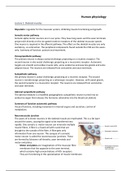Summary
Summary human physiology RUG
- Course
- Institution
- Book
Samenvatting lectures RUG boek Human physiology: An integrated approach 8th edition human physiology Summary lectures RUG book Human physiology: an integrated approach 8th edition
[Show more]




